The Temples of Angkor
Everything you’ll need to know about the Temples of Angkor:
Prepare for divine inspiration! The temples of Angkor, capital of Cambodia’s ancient Khmer empire, are a perfect fusion of creative ambition and spiritual devotion. The Cambodian god-kings of old each strove to top their ancestors in size, scale and symmetry, culminating in the world’s largest religious building, Angkor Wat, and one of its weirdest, the Bayon.
The hundreds of temples surviving today are the sacred skeleton of the vast political, religious and social centre of an empire that stretched from Burma to Vietnam and which, at its zenith, boasted a population of one million.
After the fall of the Khmer empire the Angkor temples were abandoned and reclaimed by the jungle for centuries. Situated amid dense rainforest and rice paddies, many of the temples at Angkor have now been restored and welcome over two million tourists each year.
The temples of Angkor are the heart and soul of the Kingdom of Cambodia, a source of inspiration and national pride to all Khmers as they struggle to rebuild their lives after years of terror and trauma. Today, they are a point of pilgrimage for all Cambodians, and no traveller to the region will want to miss their extravagant beauty
10 of the Most Magnificent Angkor Temples
Angkor Wat
Angkor Wat (meaning “City Temple”) is the most magnificent and largest of all Angkor temples. The structure occupies and enormous site of nearly 200 hectares (494 acres). A huge rectangular reservoir surrounds the temple which rises up through a series of three rectangular terraces to the central shrine and tower at a height of 213 meters (669 feet). This arrangement reflects the traditional Khmer idea of the temple mountain, in which the temple represent Mount Meru, the home of the gods in Hinduism.
Built under the reign of king Suryavarman II in the first half of the 12 century, Angkor Wat is the pinnacle of Khmer architecture. The famous bas-reliefs encircling the temple on the first level depict Hindu epics including the mythical “Churning of the Ocean of Milk”, a legend in which Hindu deities stir vast oceans in order to extract the nectar of immortal life. The reliefs, including thousands of female dancers, are carved into the wall of the third enclosure of the temple.
In the late 13th century, Angkor Wat gradually moved from a Hindu temple to a Theravada Buddhist one. Unlike other temples at Angkor which were abandoned after the fall of the Khmer empire in the 15th century, Angkor Wat remained a Buddhist shrine.
Bayon Temple
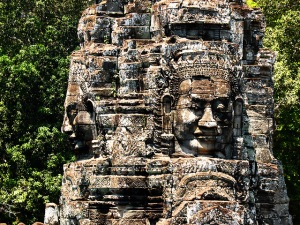
Bayon
The Bayon temple features a sea of over 200 massive stone faces looking in all direction. The curious smiling faces, thought by many to be a portrait of king Jayavarman VII himself or a combination of him and Buddha, are an instantly recognizable image of Angkor. Built in the 12th century by King Jayavarman VII as part of a massive expansion of his capital Angkor Thom, the Bayon is built at the exact center of the royal city. The Bayon is the only state temple at Angkor built primarily as a Mahayana Buddhist shrine dedicated to the Buddha. Following Jayavarman’s death, it was modified by later Hindu and Theravada Buddhist kings in accordance with their own religious beliefs.
The Bayon temple rises through three levels to a height of around 43 meters (140 feet). The outer gallery on the first level depicts scenes from everyday life and historical events, while the inner gallery on the next higher level depicts mythical figures and stories. Some of the figures depicted are Siva, Vishnu, and Brahma. The third level is where you will encounter many of the famous faces (and tourists).
Ta Prohm
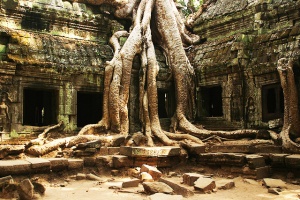
Ta Prohm
Ta Prohm is undoubtedly the most atmospheric and photogenic ruin at Angkor, with trees growing out of the ruins. Here you can still experience an India Jones moment and feel like an early explorer. If Angkor Wat and other temples are a testimony to the genius of the ancient Khmers, Ta Prohm equally reminds us of the awesome power of the jungle.
Built from 1186, Ta Prohm was a Buddhist temple dedicated to the mother of Jayavarman VII. It is one of the few temples in Angkor where an inscription provides information about the temple’s inhabitants. The temple was home to more than 12,500 people, including 18 high priests, while an additional 80,000 khmers, living in the surrounding villages, were required to maintain the temple. The inscription also notes that the temple contained gold, pearls and silks. After the fall of the Khmer empire in the 15th century, the temple was abandoned and swallowed up by the jungle
Angkor Thom

Angkor Thom
The last great capital of the Khmer empire, Angkor Thom (literally “Great City”) took monumental to a whole new level. It was built in part as a reaction to the surprise sacking of Angkor by the Chams. King Jayavarman VII decided that his empire would never again be vulnerable at home. Beyond the eight meter (26 ft) high walls is a massive moat that would have stooped all but the most determined invaders. The city wall has a sanctuary tower at each corner and five entry gates; one per cardinal direction plus an additional eastern portal, the Victory Gate. The gates each feature a tower topped by four huge faces, similar to those at the Bayon temple. The most fascinating way to enter Angkor Thom is through the south gate. The causeway here is flanked by 54 gods and 54 demons depicting parts of the popular Hindu legend “The Churning of the Ocean of Milk”.
Banteay Srei
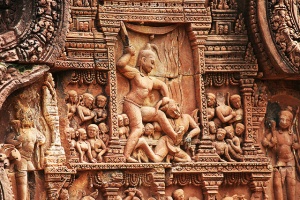
Banteay Srei
Located far (about 32 km/20 miles) from the main group of temples, Banteay Srei is one of the smallest sites at Angkor. Due to its beautiful carvings however it is extremely popular with tourists and considered a jewel of Khmer art. Built of fine grained rose-pink sandstone, the temple walls are elaborately decorated with floral motifs and epic Ramayana scenes.
Construction of Banteay Srei began in AD 967 AD. It is the only major temple at Angkor not commissioned by a king but by a brahmin named Yajnavaraha. The temple was primarily dedicated to the Hindu god Śiva. Banteay Srei, the modern name of the temple, means “Citadel of the Women” as the elaborate carvings are supposedly to fine for the hand of a man. Its original name, Tribhuvanamaheśvara, means the “great lord of the threefold world”.
Phnom Bakheng
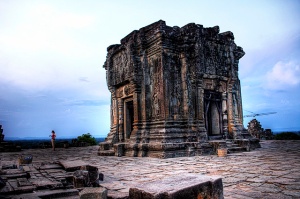
Phnom Bakheng
Dedicated to Shiva, Phnom Bakheng is a Hindu temple in the form of a temple mountain. It was constructed at the end of the 9th century, more than two centuries before Angkor Wat , during the reign of King Yasovarman. Phnom Bakheng was the architectural centerpiece of a new capital, Yasodharapura. The temple faces east and is built in a pyramid form of six tiers. Upon its completion it boasted 108 small towers around the temple at ground level and on several tiers. Only a few of the towers now remain. Located on top of a hill, the temple is a very popular tourist spot for the magnificent sunset views.
Preah Khan
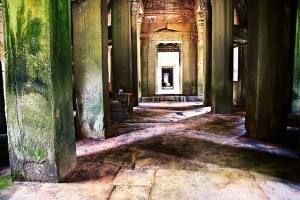
Preah Khan
The temple of Preah Kahn is one of the largest complexes at Angkor. Like the nearby Ta Prohm temple, Preah Khan has been left largely unrestored, with numerous trees growing among the ruins. Preah Khan was built by king Jayavarman VII and probably served as his temporary residence while Angkor Thom was being built. The ultimate fusion temple, Preah Khan is both a Buddhist and Hindu temple. Four ceremonial walkways approach the gates of the temple. The eastern entrance is dedicated to Mahayana Buddhism with equal-sized doors. The other principal directions are dedicated to Shiva, Vishnu and Brahma with successively smaller doors, emphasizing the unequal nature of Hinduism.
Pre Rup
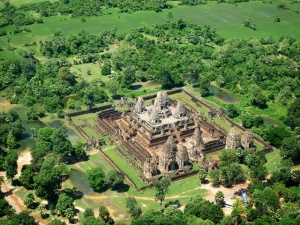
Pre Rup
With its three central spires, Pre Rup looks a bit like a mini Angkor Wat. Pre Rup was built as the state temple of king Rajendravarman in 961 and was dedicated to Shiva. It was the second temple built after the capital was returned to Angkor from Koh Ker after a period of political upheaval. Pre Rup is made of gray sandstone, which is a less durable material than the pink sandstone of some of the other temples at Angkor. As such, time and weather haven’t served the temple well and many of the complex carvings and details have been worn away by rain and erosion. It’s a crumbling temple but still magnificent in size and structure.
Banteay Kdei

Banteay Kdei
Little is known about this mysterious temple. It is presumed that Banteay Kdei was a Buddhist monastery as hundreds of Buddha statues have been excavated from the site. The temple was probably built in the 12th century, around the same time as the Ta Prohm temple. Known as ‘the citadel of cells’, its design is quite similar to Ta Prohm and Preah Khan, but less complex and smaller in scale. After the collapse of the Khmer empire it remained neglected and covered with vegetation for centuries.
………………………………………………………………………………………………….
Ta Keo

Ta Keo
Dedicated to the Hindu god Shiva, Ta Keo was built as the state temple of Jayavarman V, son of Rajendravarman, who had built the Pre Rup temple. Jayavarman V was 10 years old when he succeeded his father, in 968 AD. When he was aged 17, he began the construction of his own state temple, whose modern name is Ta Keo. The temple was never completed however. Legend has it that the temple was struck by lightning during its construction, and all work was abandoned at a stage where the main structure was complete but no external carvings had been added. Also unique is the fact that Ta Keo is made of green sandstone versus the deeper brown or grayish color of other temples at Angkor. The climb to the top of the temple is very steep, but the view is well worth it.
………………………………………………………………………………………………….
Angkorian and Pre-Angkorian Temple Ruins: Index
|
Angkor Archaeological Park/Siem Reap Province – The following temple ruins are located in Siem Reap Province, most within the boundaries of the Angkor Archaeological Park near Siem Reap City. The temple sites with the Angkor Archaeological Park represent the ruins of the ancient Angkorian capital cities and include most of the most famous Khmer temples including Angkor Wat andBayon. Click on the temple name for more details on photographs. |
|
|
| Ruin | Location | Date of Construction | King/Patron | Style |
| Ak Yum | AAP – Near the West Baray | 8th-11th century AD | — | — |
| Angkor Thom | AAP | 12th-13th century AD | Jayavarman VII | Bayon |
| Angkor Wat | AAP – 6km north of Siem Reap Town. | Early-Mid 12th century AD | Suryavarman II | Angkor Wat |
| Bakong | AAP – Roluos Group | Early 9th century AD | Indravarman | Preah Ko |
| Baksei Chamkrong | AAP/PC – Near the South Gate of Angkor Thom | Mid 10th century AD | Harshavarman | Bakheng |
| Banteay Kdei | AAP/GC | Late 12th – Early 13th century AD | Jayavarman VII | Angkor Wat/ Bayon |
| Banteay Prei | AAP/GC | Late 12th – Early 13th century AD | Jayavarman VII | Bayon |
| Banteay Samre | AAP – 4km east of East Mebon | Mid 12th century AD | Suryavarman II | Angkor Wat |
| Banteay Srey | 37km north of Siem Reap Town | Late 10th century AD | Rajendravarman | Banteay Srey |
| Baphuon | AAP/PC – Central Angkor Thom | Mid 11th century AD | Udayadityavarman II | Baphuon |
| Bat Chum | AAP/PC | Mid 10th century AD | Rajendravarman | Pre Rup |
| Bayon | AAP/PC – Central Angkor Thom | Late 12th century AD | Jayavarman VII | Bayon |
| Beng Melea | Early 11th century AD | Suryavarman II | Angkor Wat | |
| Chapel of the Hospital | AAP/PC | Late 12th century AD | Jayavarman VII | Bayon |
| Chau Say Tevoda | AAP/PC | Early 12th century AD | Suryavarman II | Angkor Wat |
| East Mebon | AAP/GC | Late 10th century AD | Rajendravarman II | Pre Rup |
| Kbal Spean | 49km north of Siem Reap Town | 11th – 13th century AD | ||
| Kleangs (North and South) | AAP/PC – Central Angkor Thom | Late 10th – Early 11th century AD | Jayavarman V | Khleang |
| Krol Ko | AAP/GC | Late 12th century AD | Jayavarman VII | Bayon |
| Krol Romeas | AAP/GC | |||
| Kutisvara | AAP/GC | 9th / 10th century AD | Jayavarman II | Preah Ko |
| Lolei | AAP – Roluos Group | Late 9th century AD | Yasovarman I | Pre Rup/Bakheng |
| Neak Pean | AAP/GC | Late 12th century AD | Jayavarman VII | Bayon |
| Phimeanakas | AAP/PC – Central Angkor Thom | Late 10th – Early 11th century AD | Jayavarman V | Khleang |
| Phnom Bakheng | AAP/PC – Near the South Gate of Angkor Thom | Late 9th – Early 10th century AD | Yasovarman I | Bakheng |
| Phnom Krom | 15km south of Siem Reap Town, near the Chong Khneas Port | Late 9th – Early 10th century AD | Yasovarman I | Bakheng |
| Phnom Kulen | 50km north of Siem Reap Town | 9th century AD | Jayavarman II | Kulen |
| Prasat Bei | AAP/PC – Near the South Gate of Angkor Thom | 10th century AD | Yasovarman I | Bakheng |
| Prasat Kravan | AAP/PC | Early 10th century AD | Harshavarman I | Pre Rup |
| Prasat Prei | AAP/GC | Late 12th – Early 13th century AD | Jayavarman VII | Bayon |
| Prasat Suor Prat | AAP/PC – Central Angkor Thom | Early 13th? century AD | Indravarman II | Post-Bayon |
| Prasat Top (East) | Angkor Thom | Late 13th century AD | Jayavarman VII | Bayon |
| Prasat Top (West) | Angkor Thom | 9th-17th century AD | Post-Bayon | |
| Pre Rup | AAP/GC | Late 10th century AD | Rajendravarman II | Pre Rup |
| Preah Khan | AAP/GC | Late 12th century AD | Jayavarman VII | Bayon |
| Preah Ko | AAP – Roluos Group | Late 9th century AD | Indravarman I | Preah Ko |
| Preah Palilay | AAP/PC – Central Angkor Thom | Late 12th – Early 13th century AD | Jayavarman VII | Bayon |
| Preah Pithu Group | AAP/PC – Central Angkor Thom | Early 12th century AD | Suryavarman II | |
| Roluos Group | AAP – Roluos Group | Late 9th century AD | ||
| Spean Thma | AAP/PC | |||
| Srah Srang | AAP/PC | Mid 10th and Late 12th century AD | Jayavarman VII | Bayon |
| Ta Keo | AAP/PC | Late 10th – Early 11th century AD | Jayavarman V | Khleang |
| Ta Nei | AAP | Mid 12th century AD | Jayavarman VII | Bayon |
| Ta Prohm | AAP/PC | Mid 12th – Early 13th century AD | Jayavarman VII | Bayon |
| Ta Prohm Kel | AAP/PC – Opposite Angkor Wat | Late 12th century AD | Jayavarman VII | Bayon |
| Ta Som | AAP/GC | Late 12th century AD century AD | Jayavarman VII | Bayon |
| Tep Pranam | AAP/PC – Central Angkor Thom | 9th century AD | Jayavarman VII | Bayon |
| Terrace of the Elephants | AAP/PC – Central Angkor Thom | Late 12th century AD | Jayavarman VII | Bayon |
| Terrace of the Leper King | AAP/PC – Central Angkor Thom | Late 12th century AD | Jayavarman VII | Bayon |
| Thma Bay Kaek | AAP/PC | Late 11th / early 12th century AD | Suryavarman II | Angkor Wat |
| Thommanon | AAP/PC | Late 11th – Early 12th century AD | Suryavarman II | Angkor Wat |
| Wat Athvea | 8km south of Siem Reap Town. | Late 11th century AD | Suryavarman II | Angkor Wat |
| West Mebon | AAP – On an island in the center of the West Baray | Late 11th century AD | Udayadityavarman VII | Baphuon |
——————————————————————————————————————–
|
Takeo Province – The following temple ruins are located in Takeo Province south of Phnom Penh. All are within day-trip’s distance of Phnom Penh, The pre-Angkorian and Angkorian-era temple ruins in Takeo Province, though not as impressive as the temples near Siem Reap, rank amongst the most historically and archaeologically important Khmer ruins in Cambodia. Most of the listed temple ruins can also be reached by Phnom Penh Sorya Transport bus. Regularly scheduled buses depart the bus station near Phnom Penh’s Central Market and follow the National Routes into the provinces. Most of the listed sites lie on or near a National Route. For sites located away from the National Route, onward transportation (usually motodups) awaits bus passengers at the bus stops. The bus station is located at the southwest corner of the Central Market (Phsar Thmey). Call 023-210359 for the bus schedule. See the Temple Ruins Near Phnom Penh Map for Takeo province temples |
| Ruin | Location | Date of Construction | King/Patron | Style |
| Angkor Borei | Takeo Province | Neolithic – 15th century AD | — | — |
| Phnom Chisor | Takeo Province, just off Route #2 | 10th-11th century AD | Suryavarman I | — |
| Phnom Da | Takeo Province | Mid-11th century AD | Rudravarman | — |
| Prasat Neang Khmau | Takeo Province, just off Route #2 | 10th century AD | Jayavarman IV | — |
| Ta Prohm at Tonle Bati | Takeo Province, at Tonle Bati resort area | 12th century AD | Jayavarman VII | — |
| Yeah Peau | Takeo Province, at Tonle Bati resort area | 12th century AD | Jayavarman VII | — |
| Abbreviations and notesAAP – Angkor Archaeological ParkAT – Angkor ThomC.E. – Current Era. Roughly equivalent to A.D.d – degrees (used to replace the usual degree symbol)
GC – Grand Circuit (The ‘grand’ or ‘large’ road circuit though the main temple complex. Indicated in green on the map.) PC – Petite Circuit (The ‘petite’ or ‘small’ road circuit though the main temple complex. Indicated in red on the map.) |
– The ‘position’ of the ruins listed on the individual temple description pages is the position of the central tower or prasat unless otherwise indicated.
Glossary
Anastylosis Archaeological technique used in reconstructing the temples ruins by dismantling and then rebuilding. This technique was used on Banteay Samre, Prasat Kravan, Thommanon and many other temples.
Angkor Angkor refers to the capital city of the Khmer Empire that existed in the area of Cambodia between the 9th and 12th centuries CE, as well as to the empire itself.
Apsara Mythological a celestial nymph. Devatas (standing female divinities), though technically different, are also referred to as apsaras in this guide. Carved in abundance on many of the temples.
Banteay (Khmer) ‘fortress’ or ‘citadel’. Though not a technical designation, it often indicates a monastic complex or flat temple style.
Baray (Khmer) A ‘baray’ is a water reservoir – an area of land where dikes have been raised to catch and hold water. Beginning in the 9th century, the construction of massive barays and other such grand projects became one of the marks of Angkorian kingship. There are four major barays in the Park area. When the barays were constructed, an island temple was set at the center of each. The first major baray to be constructed was Indratataka by King Yasovarman I, measuring 3.8km x 880m and completed in 889AD when the capital was still at Hariharalaya near Roluos. The Roluos Group temple Lolei sat on an island in the middle of Indratataka. Construction of the second major baray, the East Baray (Yashodharatataka,) began almost immediately after the first. At 7.8km x 880m it was almost five times larger than the Indratataka. Almost 50 years later, the temple East Mebon was constructed on an island in the center. The third and largest baray (8km x 2.2km) is theWest Baray built in the early 11th century. Unlike the other barays, the West Baray is still partially filled, creating good sized lake. The temple ruins of West Mebon sit on an artificial island at the center of the baray (requiring a short boat ride to visit.) The last baray (Jayatataka) was constructed by Jayavarman VII in the late 12th century. It is considered to be the baray of Preah Khan though it is Neak Pean that actually sits at the center. The function of barays is a matter of academic debate. A recent study has argued that the barays did not serve an agricultural purpose but were built and maintained solely for political/religious reasons. Conventional wisdom has it that the barays were part of a giant water works used to irrigate the rice paddies and provide water for year round cultivation, though they certainly served a political and religious function as well.
Boeung (Khmer) ‘lake’. Also spelled ‘beng’.
Champa Neighboring Indianised state, contemporary with Angkor. Located in the area of south central Vietnam.
Corbel arch False arch made from placing tiered, progressively projecting corbels on opposite walls. Used throughout Angkorian era construction.
Gopura The entrance-way or gate in the wall that surrounds a temple.
Khmer The dominant ethnic group and the language of ancient and modern Cambodia.
Linga A phallic symbol, representative of the god Shiva.
Lintel The sandstone block above doorways and windows, often intricately carved.
Monastic complex General term referring to a temple that has a relatively flat, sometimes sprawling architectural layout. It may employ towers, but set at ground level, e.g.: Ta Prohm, Preah Khan, Banteay Kdei.
Naga Mythological, multi-headed snake/serpent. Naga motifs are often used in balustrades.
Phnom (Khmer) ‘hill’ or ‘mountain’.
Prasat (Khmer) ‘tower’.
Preah (Khmer) ‘sacred’.
Reamker Khmer telling of the Ramayana, a classic and much loved epic tale from Hindu mythology – the adventures of Rama in his quest to save his kidnapped wife, Sita, from Ravana. Images from the Ramayana are carved on many temples including Angkor Wat, and traditional dance performances in Siem Reap often incorporate stories from the Ramayana.
Shiva One of the three primary gods of the Hindu trinity. The ‘destroyer’. Central to the Angkor royal linga cult. Often represented in the form of a linga.
Stele Inscribed stone tablet.
Stung (Khmer) ‘river’
Temple-mountain A specific architectural design based on the mythological mountain, Mt. Meru. Eg: Pre Rup, Ta Keo, Bakong.
Thom (Khmer) ‘big,’ e.g. Angkor Thom
-varman (Khmer) ‘protected by’. The suffix attached to the names of Khmer kings, e.g.: Suryavarman, Jayavarman.
Vihear (Khmer) Main temple building of a Buddhist pagoda or temple group. Houses the Buddha image.
Vishnu One of the three primary gods of the Hindu trinity. The ‘protector’.
Wat Modern Buddhist pagoda or temple.
Angkorian and Pre-Angkorian Temple Ruins: Index
|
Angkor Archaeological Park/Siem Reap Province – The following temple ruins are located in Siem Reap Province, most within the boundaries of the Angkor Archaeological Park near Siem Reap City. The temple sites with the Angkor Archaeological Park represent the ruins of the ancient Angkorian capital cities and include most of the most famous Khmer temples including Angkor Wat andBayon. Click on the temple name for more details on photographs.
|
|
|
|
Ruin |
Location |
Date of Construction |
King/Patron |
Style |
|
AAP – Near the West Baray |
8th-11th century AD |
— |
— |
|
|
AAP |
12th-13th century AD |
Jayavarman VII |
Bayon |
|
|
AAP – 6km north of Siem Reap Town. |
Early-Mid 12th century AD |
Suryavarman II |
Angkor Wat |
|
|
AAP – Roluos Group |
Early 9th century AD |
Indravarman |
Preah Ko |
|
|
AAP/PC – Near the South Gate of Angkor Thom |
Mid 10th century AD |
Harshavarman |
Bakheng |
|
|
AAP/GC |
Late 12th – Early 13th century AD |
Jayavarman VII |
Angkor Wat/ Bayon |
|
|
AAP/GC |
Late 12th – Early 13th century AD |
Jayavarman VII |
Bayon |
|
|
AAP – 4km east of East Mebon |
Mid 12th century AD |
Suryavarman II |
Angkor Wat |
|
|
37km north of Siem Reap Town |
Late 10th century AD |
Rajendravarman |
Banteay Srey |
|
|
AAP/PC – Central Angkor Thom |
Mid 11th century AD |
Udayadityavarman II |
Baphuon |
|
|
AAP/PC |
Mid 10th century AD |
Rajendravarman |
Pre Rup |
|
|
AAP/PC – Central Angkor Thom |
Late 12th century AD |
Jayavarman VII |
Bayon |
|
|
Early 11th century AD |
Suryavarman II |
Angkor Wat |
||
|
AAP/PC |
Late 12th century AD |
Jayavarman VII |
Bayon |
|
|
AAP/PC |
Early 12th century AD |
Suryavarman II |
Angkor Wat |
|
|
AAP/GC |
Late 10th century AD |
Rajendravarman II |
Pre Rup |
|
|
49km north of Siem Reap Town |
11th – 13th century AD |
|||
|
AAP/PC – Central Angkor Thom |
Late 10th – Early 11th century AD |
Jayavarman V |
Khleang |
|
|
AAP/GC |
Late 12th century AD |
Jayavarman VII |
Bayon |
|
|
AAP/GC |
||||
|
AAP/GC |
9th / 10th century AD |
Jayavarman II |
Preah Ko |
|
|
AAP – Roluos Group |
Late 9th century AD |
Yasovarman I |
Pre Rup/Bakheng |
|
|
AAP/GC |
Late 12th century AD |
Jayavarman VII |
Bayon |
|
|
AAP/PC – Central Angkor Thom |
Late 10th – Early 11th century AD |
Jayavarman V |
Khleang |
|
|
AAP/PC – Near the South Gate of Angkor Thom |
Late 9th – Early 10th century AD |
Yasovarman I |
Bakheng |
|
|
Phnom Krom |
15km south of Siem Reap Town, near the Chong Khneas Port |
Late 9th – Early 10th century AD |
Yasovarman I |
Bakheng |
|
Phnom Kulen |
50km north of Siem Reap Town |
9th century AD |
Jayavarman II |
Kulen |
|
AAP/PC – Near the South Gate of Angkor Thom |
10th century AD |
Yasovarman I |
Bakheng |
|
|
AAP/PC |
Early 10th century AD |
Harshavarman I |
Pre Rup |
|
|
AAP/GC |
Late 12th – Early 13th century AD |
Jayavarman VII |
Bayon |
|
|
AAP/PC – Central Angkor Thom |
Early 13th? century AD |
Indravarman II |
Post-Bayon |
|
|
Angkor Thom |
Late 13th century AD |
Jayavarman VII |
Bayon |
|
|
Angkor Thom |
9th-17th century AD |
Post-Bayon |
||
|
AAP/GC |
Late 10th century AD |
Rajendravarman II |
Pre Rup |
|
|
AAP/GC |
Late 12th century AD |
Jayavarman VII |
Bayon |
|
|
AAP – Roluos Group |
Late 9th century AD |
Indravarman I |
Preah Ko |
|
|
AAP/PC – Central Angkor Thom |
Late 12th – Early 13th century AD |
Jayavarman VII |
Bayon |
|
|
AAP/PC – Central Angkor Thom |
Early 12th century AD |
Suryavarman II |
||
|
AAP – Roluos Group |
Late 9th century AD |
|||
|
AAP/PC |
||||
|
AAP/PC |
Mid 10th and Late 12th century AD |
Jayavarman VII |
Bayon |
|
|
AAP/PC |
Late 10th – Early 11th century AD |
Jayavarman V |
Khleang |
|
|
AAP |
Mid 12th century AD |
Jayavarman VII |
Bayon |
|
|
AAP/PC |
Mid 12th – Early 13th century AD |
Jayavarman VII |
Bayon |
|
|
AAP/PC – Opposite Angkor Wat |
Late 12th century AD |
Jayavarman VII |
Bayon |
|
|
AAP/GC |
Late 12th century AD century AD |
Jayavarman VII |
Bayon |
|
|
AAP/PC – Central Angkor Thom |
9th century AD |
Jayavarman VII |
Bayon |
|
|
AAP/PC – Central Angkor Thom |
Late 12th century AD |
Jayavarman VII |
Bayon |
|
|
AAP/PC – Central Angkor Thom |
Late 12th century AD |
Jayavarman VII |
Bayon |
|
|
AAP/PC |
Late 11th / early 12th century AD |
Suryavarman II |
Angkor Wat |
|
|
AAP/PC |
Late 11th – Early 12th century AD |
Suryavarman II |
Angkor Wat |
|
|
8km south of Siem Reap Town. |
Late 11th century AD |
Suryavarman II |
Angkor Wat |
|
|
AAP – On an island in the center of the West Baray |
Late 11th century AD |
Udayadityavarman VII |
Baphuon |
——————————————————————————————————————–
|
Takeo Province – The following temple ruins are located in Takeo Province south of Phnom Penh. All are within day-trip’s distance of Phnom Penh, The pre-Angkorian and Angkorian-era temple ruins in Takeo Province, though not as impressive as the temples near Siem Reap, rank amongst the most historically and archaeologically important Khmer ruins in Cambodia. Most of the listed temple ruins can also be reached by Phnom Penh Sorya Transport bus. Regularly scheduled buses depart the bus station near Phnom Penh’s Central Market and follow the National Routes into the provinces. Most of the listed sites lie on or near a National Route. For sites located away from the National Route, onward transportation (usually motodups) awaits bus passengers at the bus stops. The bus station is located at the southwest corner of the Central Market (Phsar Thmey). Call 023-210359 for the bus schedule. See the Temple Ruins Near Phnom Penh Map for Takeo province temples |
|
Ruin |
Location |
Date of Construction |
King/Patron |
Style |
|
Takeo Province |
Neolithic – 15th century AD |
— |
— |
|
|
Takeo Province, just off Route #2 |
10th-11th century AD |
Suryavarman I |
— |
|
|
Takeo Province |
Mid-11th century AD |
Rudravarman |
— |
|
|
Takeo Province, just off Route #2 |
10th century AD |
Jayavarman IV |
— |
|
|
Takeo Province, at Tonle Bati resort area |
12th century AD |
Jayavarman VII |
— |
|
|
Takeo Province, at Tonle Bati resort area |
12th century AD |
Jayavarman VII |
— |
|
Abbreviations and notes AAP – Angkor Archaeological Park AT – Angkor Thom C.E. – Current Era. Roughly equivalent to A.D. d – degrees (used to replace the usual degree symbol) GC – Grand Circuit (The ‘grand’ or ‘large’ road circuit though the main temple complex. Indicated in green on the map.) PC – Petite Circuit (The ‘petite’ or ‘small’ road circuit though the main temple complex. Indicated in red on the map.) – The ‘position’ of the ruins listed on the individual temple description pages is the position of the central tower or prasat unless otherwise indicated. Glossary Anastylosis Archaeological technique used in reconstructing the temples ruins by dismantling and then rebuilding. This technique was used on Banteay Samre, Prasat Kravan, Thommanon and many other temples. Angkor Angkor refers to the capital city of the Khmer Empire that existed in the area of Cambodia between the 9th and 12th centuries CE, as well as to the empire itself. Apsara Mythological a celestial nymph. Devatas (standing female divinities), though technically different, are also referred to as apsaras in this guide. Carved in abundance on many of the temples. Banteay (Khmer) ‘fortress’ or ‘citadel’. Though not a technical designation, it often indicates a monastic complex or flat temple style. Baray (Khmer) A ‘baray’ is a water reservoir – an area of land where dikes have been raised to catch and hold water. Beginning in the 9th century, the construction of massive barays and other such grand projects became one of the marks of Angkorian kingship. There are four major barays in the Park area. When the barays were constructed, an island temple was set at the center of each. The first major baray to be constructed was Indratataka by King Yasovarman I, measuring 3.8km x 880m and completed in 889AD when the capital was still at Hariharalaya near Roluos. The Roluos Group temple Lolei sat on an island in the middle of Indratataka. Construction of the second major baray, the East Baray (Yashodharatataka,) began almost immediately after the first. At 7.8km x 880m it was almost five times larger than the Indratataka. Almost 50 years later, the temple East Mebon was constructed on an island in the center. The third and largest baray (8km x 2.2km) is theWest Baray built in the early 11th century. Unlike the other barays, the West Baray is still partially filled, creating good sized lake. The temple ruins of West Mebon sit on an artificial island at the center of the baray (requiring a short boat ride to visit.) The last baray (Jayatataka) was constructed by Jayavarman VII in the late 12th century. It is considered to be the baray of Preah Khan though it is Neak Pean that actually sits at the center. The function of barays is a matter of academic debate. A recent study has argued that the barays did not serve an agricultural purpose but were built and maintained solely for political/religious reasons. Conventional wisdom has it that the barays were part of a giant water works used to irrigate the rice paddies and provide water for year round cultivation, though they certainly served a political and religious function as well. Boeung (Khmer) ‘lake’. Also spelled ‘beng’. Champa Neighboring Indianised state, contemporary with Angkor. Located in the area of south central Vietnam. Corbel arch False arch made from placing tiered, progressively projecting corbels on opposite walls. Used throughout Angkorian era construction. Gopura The entrance-way or gate in the wall that surrounds a temple. Khmer The dominant ethnic group and the language of ancient and modern Cambodia. Linga A phallic symbol, representative of the god Shiva. Lintel The sandstone block above doorways and windows, often intricately carved. Monastic complex General term referring to a temple that has a relatively flat, sometimes sprawling architectural layout. It may employ towers, but set at ground level, e.g.: Ta Prohm, Preah Khan, Banteay Kdei. Naga Mythological, multi-headed snake/serpent. Naga motifs are often used in balustrades. Phnom (Khmer) ‘hill’ or ‘mountain’. Prasat (Khmer) ‘tower’. Preah (Khmer) ‘sacred’. Reamker Khmer telling of the Ramayana, a classic and much loved epic tale from Hindu mythology – the adventures of Rama in his quest to save his kidnapped wife, Sita, from Ravana. Images from the Ramayana are carved on many temples including Angkor Wat, and traditional dance performances in Siem Reap often incorporate stories from the Ramayana. Shiva One of the three primary gods of the Hindu trinity. The ‘destroyer’. Central to the Angkor royal linga cult. Often represented in the form of a linga. Stele Inscribed stone tablet. Stung (Khmer) ‘river’ Temple-mountain A specific architectural design based on the mythological mountain, Mt. Meru. Eg: Pre Rup, Ta Keo, Bakong. Thom (Khmer) ‘big,’ e.g. Angkor Thom -varman (Khmer) ‘protected by’. The suffix attached to the names of Khmer kings, e.g.: Suryavarman, Jayavarman. Vihear (Khmer) Main temple building of a Buddhist pagoda or temple group. Houses the Buddha image. Vishnu One of the three primary gods of the Hindu trinity. The ‘protector’. Wat Modern Buddhist pagoda or temple.
Home / About / Moto / Jeep / Culture / Gallery / Package /Contact ©2016 Sabai Adventures Cambodia
|
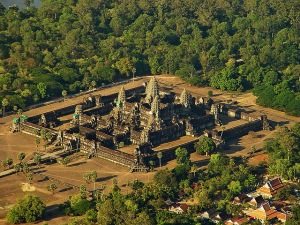


Leave a comment
Comments 0